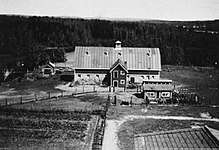St. John's Indian Residential School

The St. John's Indian Residential School also known as the Chapleau Indian Residential School was a Canadian Indian Residential School operated by the Anglican Church of Canada from 1907-1950 in Chapleau, Ontario.
History
The original residential school in Chapleau, Ontario was operated by the Anglican Diocese of Moosonee from 1907 to 1920. In 1920 the school's administration was taken over by the Department of Indian Affairs. The school was built to accommodate forty students and in 1919 it was expanded to accommodate 45 students.[1] The residential school was located on 153 acres on the east Side of Chapleau near the Nebskwashi River.[2]
By 1912 it was decided that the current building was too small to accommodate the school. In 1914 a new location of 1,184 acres was bought from the Ontario government for one dollar an acre. However, the new location was far from the town of Chapleau and did not have convenient road access. In 1920 a new site 2,142 acre site, closer to town, was purchased.[1] The new two-storey school building designed to accommodate 100 students was built at a cost of $89,000.[2]
The school operated at capacity until it closed on July 1, 1948.[3] Following the closure of the St. John's School many of the students were transferred to the Shingwauk Indian Residential School or the Moose Factory Indian Residential School.
The original residential school site in Chapleau was has since been used for development.[4]
School Cemetery
For many years the cemetery associated with the St. John's School was unmarked. Chapleau Cree First Nation has since worked to put a fence around the cemetery and install a plaque as a form of commemoration.[4]
As part of the Truth and Reconciliation Commission of Canada's missing children residential school cemetery project, archeologists identified 42 grave sites in the cemetery associated with the newer St. John's Residential School building that operated from 1920-1948.[5]
Student Experience

Students came to St. John's School largely from the Diocese of Moosonee region including New Bruniswick House, Chapleau Cree, Missanabie Cree First Nation, Fort Albany, Fort Frances, and Six Nations, Nipigon.[2] Like at residential schools across Canada, students at St. John's were forbidden from speaking their traditional Indigenous languages, hash punishments were used, and attended school based on a half-day system.[6]
From April 1 to June 30, 1908 seven student of thirty one students died while attending the school for 'unknown reasons'.[1]
In 1921 many parents complained about the Rev. Prewer's role as principal and his treatment of students at the school. In the same year over 150 people traveled to Chapleau to voice their complaints over the cruelty and neglect of the children at the school.[1]
Principals
The following individuals served as principals of the St. John's Indian Residential School:[3]
| Name | Dates |
|---|---|
| Rev. Ernest O. Duke | 1908 |
| Rev. P.R. Soanes | 1909-1912 |
| Miss G.M. Sutherland | 1912-1913 |
| Rev. George E. Prewer | 1913-1923 |
| Rev. J.H. Gibson | 1912-1927 |
| Rev. G.T. Snowden (Vice-Principal, Acting Principal) | 1925-1927 |
| Rev. Alf J. Vale | 1927-1946 |
| Rev. G.A. Crawley | 1946-1948 |
References
- 1 2 3 4 Auger, Donald J. (2005). Indian Residential Schools In Ontario. Nishnawbe Aski Nation. pp. 135–146.
- 1 2 3 "St. John’s School — Chapleau, ON - Anglican Church of Canada". Anglican Church of Canada. Retrieved 2017-07-06.
- 1 2 "Chapleau (St. John's) IRS School Narrative" (PDF). National Centre for Truth and Reconciliation. April 23, 2007. Retrieved July 6, 2017.
- 1 2 "Why Ontario’s residential school sites are a chance for reconciliation". TVO. 2015-06-18. Retrieved 2017-07-06.
- ↑ "NAN, Chapleau Cree and Community Commemorate Residential School Gravesite" (PDF). Nishnawbe Aski Nation. August 16, 2013. Retrieved July 6, 2017.
- ↑ Wisniewski, Dominik (2013-07-08). "Port Hope students hear about life at First Nations residential school | NorthumberlandNews.com". NorthumberlandNews.com. Retrieved 2017-07-06.